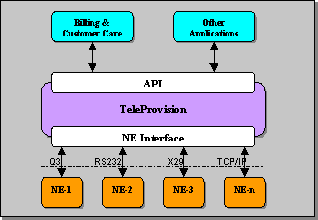|
TeleProvision
(Subscriber
Services Provisioning Gateway)
Service
Provisioning is the overall process of making services
available to subscribers or users of the
telecommunications network. In
a telecommunications network environment, to be enabled
to use the network services, the subscribers need to be
provisioned on one or more network elements such as
Authentication Center (AuC), Home Location Register (HLR), Voice Mail System (VMS), RADIUS Server (AAA),
Global Location Register (GLR), Short Messaging Service
Center (SMSC) and so on. The
provisioning process is a part of Billing & Customer
Care system that decides which subscriber are allowed
what network services. For instances, some subscribers
may be allowed to have VMS and International Roaming
services while others are not, some subscriber need to
be marked as pre-paid subscribers while others as
post-paid, some subscribers may need to have
an expiry date, and so on.
Virtually,
every type of network element offers its own
provisioning interface, making it impossible for a
Billing & Customer Care (BCC) system to interface itself
to all kinds of network elements present in the network. For instance, the
method used to add a new subscriber in Ericsson AXE AuC/HLR is quite different from that used in Siemens
D900 AuC/HLR (i.e., both offer different interfaces),
whether it is protocol or provisioning command format. In
this situation, TeleProvision comes to BCC's rescue.
TeleProvision interfaces with a wide variety of network
elements on the network side, but still offers a single,
uniform interface towards the Billing & Customer
Care system. New types of network elements can be added
in the network without any changes in the Billing &
Customer Care system as far as interfacing with the new network elements is concerned. TeleProvision
supports provisioning of all the telecom services that
exist in GSM/GPRS, CDMA and Landline networks.
TeleProvision also supports supplementary network
elements such as SMSC, VMS, AAA, etc.
Interoperability
Interoperability tests with a variety of network
elements is part of the TeleProvision Quality Assurance
process. The company is working with our clients to
continually expand the list of supported network
elements.
TeleProvision
has been successfully interfaced to a number of network
elements such as Siemens D900 AuC/HLR, Samsung CDMA2000
AuC/HLR, Samsung GLR, Cisco CAR (AAA), Digitalwave VMS,
Ericsson AXE AuC/HLR, etc., using a wide variety of
protocols like Q3, Telnet, RSH, X29PAD, RS232 and proprietary
messaging over TCPIP.
TeleProvision
Architecture
The
architecture of TeleProvision is given below.

The
Billing & Customer Care (BCC) system generates
provisioning requests that need to be executed on one or
more network elements. These requests might be stored in
a database proprietary to the BCC system. A process of BCC
responsible for firing requests on network elements
reads these requests, calls on the TeleProvision API
functions for execution. The TeleProvision interfaces with
the appropriate network element and executes the
provisioning request on it, and returns the result back
to the BCC process.
Features
and Functions
-
Network
Types
-
Actions
-
Create, Remove, Suspend and
Resume a subscriber
-
Change
IMSI/MSISDN/MIN/MDN of
a subscriber
-
Provisioning
and Withdrawal, Activation
and Deactivation, Registration
and Eraser of Tele-Services or Bearer-Services or
Supplementary Services and their parameters
-
Operator Determined Barring
of outgoing and incoming calls (No Calls, Local Calls, National Calls and
International Calls), Roaming Control (No
Roaming, National Roaming, International
Roaming), Operator
Specific Barring, Enable Call Tracing, Change
Password, etc
|
